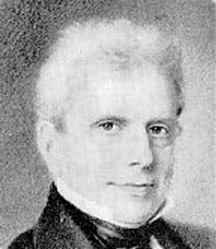Georgios Sinas
Georgios Sinas | |
|---|---|
Γεώργιος Σίνας | |
 Contemporary portrait | |
| Born | November 20, 1783 |
| Died | May 18, 1856 (aged 72) |
| Nationality | Greece |
| Occupation | Businessman |
| Known for | Banking and benefaction |
Georgios Sinas (Greek: Γεώργιος Σίνας, German: Georg Sina, 20 November 1783 - 18 May 1856) was a Greek entrepreneur, banker, national benefactor of Greece and father of the Greek national benefactor of Austria, Simon Sinas. He was the founder of the Athens National Observatory.
Biography
Georgios Sinas was born in Moschopolis of Greek [1][2][3][4][5] Aromanian origin,[6] to Northern Epirote parents.[7][8] At an early age Sinas lost his mother and was raised by his aunt in Serres (modern Greece), where he lived his first school years. About 1790 he moved with his father, the tobacco and cotton merchant Georgios Sinas the Elder (1753–1822), to the Habsburg residence Vienna, where he finished his ground level studies. At the age of 20, he became involved with his father's businesses and managed to take initiatives and successfully expanded the family business.
He became chief director of the National bank of Austria, a position that he retained for 25 years. Moreover, he became a successful banker and subsidized not only enterprises but states and royal families in Europe.[9] Already in 1818, he and his father were raised to Hungarian nobility by Emperor Francis I of Austria. He has contributed financially in the construction of the Chain Bridge (Budapest), the first permanent connection across the Danube between Buda and Pest, which is used even today. His name is inscribed on the base of the south western foundation of the bridge on the Buda side.
Georgios Sinas retained relations with the newly established Kingdom of Greece and in 1833 was made the ambassador of Greece to Austria by King Otto, a position he held for the rest of his life. He financially supported the Greek community in Vienna and his family's hometown of Moscopole (in Northern Epirus in southern region of Albania).[10][11][12] Moreover, he donated huge amounts of money to philanthropic, cultural and educational institutions of the Greek state, like:
- Arsakeio school in Athens.
- University of Athens.
- A number of medical and archaeological institutions.
Sinas' greatest donation to Greece was the financing of the Athens National Observatory (1845) a work of the Danish architect Theophil Hansen.[13] His son Simon Sinas, continued his work on the fields of business and benefaction.
References
- ^ Cameron, Rondo E.; Bovykin, Ivanovich, Valery; Ananʹich, B. V. (1991). International banking, 1870-1914. Oxford University Press US. p. 328. ISBN 0-19-506271-X.
A banker named Sina of Greek origin, who was known to have good French contact.
{{cite book}}: CS1 maint: multiple names: authors list (link) - ^ Landes, David S. (2006). Dynasties: fortunes and misfortunes of the world's great family businesses. Viking. p. 64. ISBN 0-670-03338-3.
Baron Georg von Sina, banker of Greek extraction and longtime pillar of Austrian finance, joined them in this endeavor, while gaining the valuable
- ^ Pfeiffer, Ida (2008). A Woman's Journey Round the World. BiblioBazaar. p. 514. ISBN 0-554-23516-1.
The small observatory was built by Baron Sina, the well-known banker in Vienna, who is by birth a Greek. The royal palace, which is of modern date, is built of brilliant white marble, in the form of a large quadrangle.
- ^ Kohl, Johann Georg (1844). Austria: Vienna, Prague, Hungary, Bohemia, and the Danube; Galicia, Styria, Moravia, Bukovina, and the Military Frontier. Chapman and Hall. p. 126.
The principal banker, Sina, is a Greek. Since the late improvements in the navigation of the Danube, which have made it possible to travel from Vienna
- ^ Gerő, András; Poór, János (1997). Budapest: a history from its beginnings to 1998. Social Science Monographs. p. 83. ISBN 0-88033-359-6.
In George Sina, a Viennese banker of Greek extraction, he found his financier; in William Tierney Clark his designer and in Adam Clark his engineer
- ^ A Concise History of Greece. Richard Clogg. Cambridge University Press, 2002. ISBN 0-521-00479-9
- ^ Edgar Augustus Jerome Johnson. The Journal of economic history. vol. 20. Economic History Association at Johns Hopkins University., 1960, p. 302: "The Sina merchant family of Moschopolis settled in Sarajevo c. 1750"
- ^ Βορειοηπειρώτες ευεργέτες
- ^ http://www.alanier.at/Sina1.html (English and German)
- ^ Edgar Augustus Jerome Johnson. The Journal of economic history. vol. 20. Economic History Association at Johns Hopkins University., 1960, p. 302: "The Sina merchant family of Moschopolis settled in Sarajevo c. 1750"
- ^ William O. McCagg. Jewish nobles and geniuses in modern Hungary. East European Quarterly; distributed by Columbia University Press, New York, 1972, p. 54: "By the time the vengeful Turks had let Albanian robbers sack Moschopolis in the 1780s, Sina was sufficiently rich to be invulnerable to this disaster, which ruined many of his compatriots"
- ^ Richard Clogg. A concise history of Greece. Cambridge University Press, 2002, ISBN 978-0-521-00479-4 p. 77: "Simon Sinas, a Hellenized Vlach whose family came from Moschopolis"
- ^ Imperialism and Science: Social Impact and Interaction. George Vlahakis. ABC-CLIO, 2006. ISBN 1-85109-673-6
